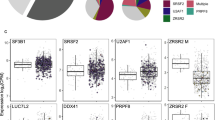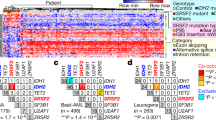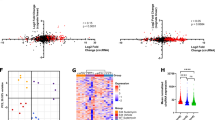Abstract
We previously identified missense mutations in the U2AF1 splicing factor affecting codons S34 (S34F and S34Y) or Q157 (Q157R and Q157P) in 11% of the patients with de novo myelodysplastic syndrome (MDS). Although the role of U2AF1 as an accessory factor in the U2 snRNP is well established, it is not yet clear how these mutations affect splicing or contribute to MDS pathophysiology. We analyzed splice junctions in RNA-seq data generated from transfected CD34+ hematopoietic cells and found significant differences in the abundance of known and novel junctions in samples expressing mutant U2AF1 (S34F). For selected transcripts, splicing alterations detected by RNA-seq were confirmed by analysis of primary de novo MDS patient samples. These effects were not due to impaired U2AF1 (S34F) localization as it co-localized normally with U2AF2 within nuclear speckles. We further found evidence in the RNA-seq data for decreased affinity of U2AF1 (S34F) for uridine (relative to cytidine) at the e-3 position immediately upstream of the splice acceptor site and corroborated this finding using affinity-binding assays. These data suggest that the S34F mutation alters U2AF1 function in the context of specific RNA sequences, leading to aberrant alternative splicing of target genes, some of which may be relevant for MDS pathogenesis.
This is a preview of subscription content, access via your institution
Access options
Subscribe to this journal
Receive 12 print issues and online access
$259.00 per year
only $21.58 per issue
Buy this article
- Purchase on Springer Link
- Instant access to full article PDF
Prices may be subject to local taxes which are calculated during checkout





Similar content being viewed by others
References
Graubert TA, Shen D, Ding L, Okeyo-Owuor T, Lunn CL, Shao J et al. Recurrent mutations in the U2AF1 splicing factor in myelodysplastic syndromes. Nat Genet 2012; 44: 53–57.
Yoshida K, Sanada M, Shiraishi Y, Nowak D, Nagata Y, Sato Y et al. Frequent pathway mutations of splicing machinery in myelodysplasia. Nature 2011; 478: 64–69.
Papaemmanuil E, Cazzola M, Boultwood J, Malcovati L, Vyas P, Bowen D et al. Somatic SF3B1 mutation in myelodysplasia with ring sideroblasts. N Engl J Med 2011; 365: 1384–1395.
Mian SA, Smith AE, Kulasekararaj AG, Kizilors A, Mohamedali AM, Lea NC et al. Spliceosome mutations exhibit specific associations with epigenetic modifiers and proto-oncogenes mutated in myelodysplastic syndrome. Haematologica 2013; 98: 1058–1066.
Visconte V, Makishima H, Jankowska A, Szpurka H, Traina F, Jerez A et al. SF3B1, a splicing factor is frequently mutated in refractory anemia with ring sideroblasts. Leukemia 2012; 26: 542–545.
Makishima H, Visconte V, Sakaguchi H, Jankowska AM, Abu Kar S, Jerez A et al. Mutations in the spliceosome machinery, a novel and ubiquitous pathway in leukemogenesis. Blood 2012; 119: 3203–3210.
Cancer Genome Atlas Research Network. Genomic and epigenomic landscapes of adult de novo acute myeloid leukemia. N Engl J Med 2013; 368: 2059–2074.
Quesada V, Conde L, Villamor N, Ordonez GR, Jares P, Bassaganyas L et al. Exome sequencing identifies recurrent mutations of the splicing factor SF3B1 gene in chronic lymphocytic leukemia. Nat Genet 2012; 44: 47–52.
Wang L, Lawrence MS, Wan Y, Stojanov P, Sougnez C, Stevenson K et al. SF3B1 and other novel cancer genes in chronic lymphocytic leukemia. N Engl J Med 2011; 365: 2497–2506.
Rossi D, Bruscaggin A, Spina V, Rasi S, Khiabanian H, Messina M et al. Mutations of the SF3B1 splicing factor in chronic lymphocytic leukemia: association with progression and fludarabine-refractoriness. Blood 2011; 118: 6904–6908.
Wu S, Romfo CM, Nilsen TW, Green MR . Functional recognition of the 3[prime] splice site AG by the splicing factor U2AF35. Nature 1999; 402: 832–835.
Ruskin B, Zamore PD, Green MR . A factor, U2AF, is required for U2 snRNP binding and splicing complex assembly. Cell 1988; 52: 207–219.
Zhang M, Zamore PD, Carmo-Fonseca M, Lamond AI, Green MR . Cloning and intracellular localization of the U2 small nuclear ribonucleoprotein auxiliary factor small subunit. Proc Natl Acad Sci 1992; 89: 8769–8773.
Zamore PD, Green MR . Identification, purification, and biochemical characterization of U2 small nuclear ribonucleoprotein auxiliary factor. Proc Natl Acad Sci 1989; 86: 9243–9247.
Berglund JA, Abovich N, Rosbash M . A cooperative interaction between U2AF65 and mBBP/SF1 facilitates branchpoint region recognition. Genes Dev 1998; 12: 858–867.
Rudner DZ, Breger KS, Kanaar R, Adams MD, Rio DC . RNA binding activity of heterodimeric splicing factor U2AF: at least one RS domain is required for high-affinity binding. Mol Cell Biol 1998; 18: 4004–4011.
Wu JY, Maniatis T . Specific interactions between proteins implicated in splice site selection and regulated alternative splicing. Cell 1993; 75: 1061–1070.
Prigge JR, Iverson SV, Siders AM, Schmidt EE . Interactome for auxiliary splicing factor U2AF65 suggests diverse roles. Biochim Biophys Acta 2009; 1789: 487–492.
Damm F, Kosmider O, Gelsi-Boyer V, Renneville A, Carbuccia N, Hidalgo-Curtis C et al. Mutations affecting mRNA splicing define distinct clinical phenotypes and correlate with patient outcome in myelodysplastic syndromes. Blood 2012; 119: 3211–3218.
Przychodzen B, Jerez A, Guinta K, Sekeres MA, Padgett R, Maciejewski JP et al. Patterns of missplicing due to somatic U2AF1 mutations in myeloid neoplasms. Blood 2013; 122: 999–1006.
Thol F, Kade S, Schlarmann C, Löffeld P, Morgan M, Krauter J et al. Frequency and prognostic impact of mutations in SRSF2, U2AF1, and ZRSR2 in patients with myelodysplastic syndromes. Blood 2012; 119: 3578–3584.
Walter MJ, Shen D, Shao J, Ding L, White BS, Kandoth C et al. Clonal diversity of recurrently mutated genes in myelodysplastic syndromes. Leukemia 2013; 27: 1275–1282.
Jenkins JL, Shen H, Green MR, Kielkopf CL . Solution conformation and thermodynamic characteristics of RNA binding by the splicing factor U2AF65. J Biol Chem 2008; 283: 33641–33649.
Kobayashi H, Carbonaro D, Pepper K, Petersen D, Ge S, Jackson H et al. Neonatal gene therapy of MPS I mice by intravenous injection of a lentiviral vector. Mol Ther 2005; 11: 776–789.
Fu Y, Masuda A, Ito M, Shinmi J, Ohno K . AG-dependent 3′-splice sites are predisposed to aberrant splicing due to a mutation at the first nucleotide of an exon. Nucleic Acids Res 2011; 39: 4396–4404.
Cancer Genome Atlas Research N. Genomic and epigenomic landscapes of adult de novo acute myeloid leukemia. N Engl J Med 2013; 368: 2059–2074.
Reed R . The organization of 3' splice-site sequences in mammalian introns. Genes Dev 1989; 3: 2113–2123.
Pacheco TR, Coelho MB, Desterro JMP, Mollet I, Carmo-Fonseca M . In vivo requirement of the small subunit of U2AF for recognition of a weak 3′ splice site. Mol Cell Biol 2006; 26: 8183–8190.
Guth S, Martínez C, Gaur RK, Valcárcel J . Evidence for substrate-specific requirement of the splicing factor U2AF35 and for its function after polypyrimidine tract recognition by U2AF65. Mol Cell Biol 1999; 19: 8263–8271.
Brooks AN, Choi PS, de Waal L, Sharifnia T, Imielinski M, Saksena G et al. A pan-cancer analysis of transcriptome changes associated with somatic mutations in U2AF1 reveals commonly altered splicing events. PLoS One 2014; 9: e87361.
Chusainow J, Ajuh PM, Trinkle-Mulcahy L, Sleeman JE, Ellenberg J, Lamond AI . FRET analyses of the U2AF complex localize the U2AF35/U2AF65 interaction in vivo and reveal a novel self-interaction of U2AF35. RNA 2005; 11: 1201–1214.
Gama-Carvalho M, Krauss RD, Chiang L, Valcárcel J, Green MR, Carmo-Fonseca M . Targeting of U2AF65 to sites of active splicing in the nucleus. J Cell Biol 1997; 137: 975–987.
Webb CJ, Wise JA . The splicing factor U2AF small subunit is functionally conserved between fission yeast and humans. Mol Cell Biol 2004; 24: 4229–4240.
Lai WS, Kennington EA, Blackshear PJ . Interactions of CCCH zinc finger proteins with mRNA: non-binding tristetraprolin mutants exert an inhibitory effect on degradation of Au-rich element-containing mRNAs. J Biol Chem 2002; 277: 9606–9613.
Liang J, Song W, Tromp G, Kolattukudy P, Fu M . Genome-wide survey and expression profiling of CCCH-zinc finger family reveals a functional module in macrophage activation. PLoS One 2008; 3: 1371.
Acknowledgements
This work was supported by Barnes-Jewish Hospital Foundation (7603-55 to BSW), an NIH/NCI SPORE in Leukemia (P50CA171063 to TAG, MJW and BSW), an NIH/NCI grant (1K12CA167540 to BSW), a Clinical and Translational Award from the NIH National Center for Advancing Translational Sciences (UL1 TR000448 to BSW), a Howard Hughes Medical Institute Physician-Scientist Early Career Award and Leukemia and Lymphoma Society Scholar Award (to MJW), a Leukemia and Lymphoma Society Translational Research Award (to TAG), and NIH R01 GM070503 (to CLK). Technical assistance was provided by the Alvin J. Siteman Cancer Center High Speed Cell Sorting core (supported in part by P30CA91842), Molecular Microbiology Imaging Facility (MMIF), the Genome Technology Access Center (GTAC) and the Genome Institute. Additional technical support was provided by Masayo Izumi. We are grateful to Dr Christopher R Cabanski for assistance with edgeR and Dr Cara Lunn Shirai for helpful scientific discussions.
Author Contributions
The study was designed by TOO, TAG and MJW; RNA affinity assays were performed by KML, RC and CLK; sub-cellular localization and junction validation experiments performed by TOO; minigene assays were performed by DM, TOO and SK; Bioinformatics analysis was performed by BSW, MG, LD, SKK and JH; the manuscript was written and edited by TOO, BSW, MG, TJL, CLK, TAG and MJW; all co-authors reviewed and approved the submission.
Author information
Authors and Affiliations
Corresponding author
Ethics declarations
Competing interests
The authors declare no conflict of interest.
Additional information
Supplementary Information accompanies this paper on the Leukemia website
Supplementary information
Rights and permissions
About this article
Cite this article
Okeyo-Owuor, T., White, B., Chatrikhi, R. et al. U2AF1 mutations alter sequence specificity of pre-mRNA binding and splicing. Leukemia 29, 909–917 (2015). https://doi.org/10.1038/leu.2014.303
Received:
Revised:
Accepted:
Published:
Issue Date:
DOI: https://doi.org/10.1038/leu.2014.303
This article is cited by
-
Impact of U2AF1 mutations on circular RNA expression in myelodysplastic neoplasms
Leukemia (2023)
-
Multi-omics reveals mitochondrial metabolism proteins susceptible for drug discovery in AML
Leukemia (2022)
-
Emerging roles of spliceosome in cancer and immunity
Protein & Cell (2022)
-
Alternative splicing and cancer: a systematic review
Signal Transduction and Targeted Therapy (2021)
-
U2AF1 mutation promotes tumorigenicity through facilitating autophagy flux mediated by FOXO3a activation in myelodysplastic syndromes
Cell Death & Disease (2021)



